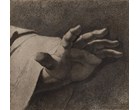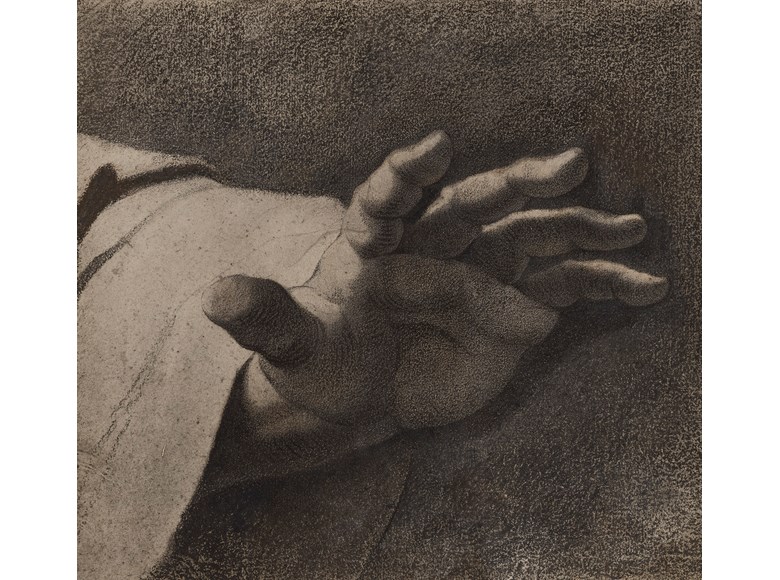 BACK TO GALLERY
BACK TO GALLERY
Lowell Libson & Jonny Yarker Ltd
Ozias Humphry
A study from Raphael's 'The Transfiguration'
10 x 10 ¾ inches; 254 x 273 mm
description
These impressive drawings represent fascinating evidence of artistic education in mid-eighteenth-century Europe. Made by the British miniaturist Ozias Humphry on his arrival in Rome in 1773, the drawings are rare, documented examples of an artist copying directly from an original old master on the Grand Tour. Thanks to Humphry’s surviving correspondence we can reconstruct the precise context in which these studies after Raphael were made. Humphry travelled to Italy with the painter George Romney, arriving in Rome in June 1773, where they found Raphael’s Transfiguration in the process of being copied by William Parry, a pupil of Joshua Reynolds. It was exceptionally rare that permission was given for Raphael’s late masterpiece, installed in the church of San Pietro in Montorio on the Janiculum hill, to be copied and even rarer for scaffolding to have been erected for the purpose. In a draft letter to his patron John Sackville, 3rd Duke of Dorset now in the Royal Academy archive, Humphry noted that to enable Parry to make his copy: ‘he had a scaffold and other conveniences erected’ adding that he used it to make studies of aspects of the painting. The result, unlike Parry, was not a full-scale painted replica, but careful tracings of individual details, two of which he worked up into these expressive studies. The drawings show the radically foreshortened hand and foot of the Apostle St Matthew in the foreground of the composition.
Copying was a staple of artistic education in Grand Tour Italy, but the practical difficulty of executing full-size repetitions of celebrated frescos or altarpieces situated in working churches meant that many artists relied on making reduced studies or sketches of individual elements. The presence of scaffolding in San Pietro in Montorio therefore offered a rare opportunity to take accurate tracings from Raphael’s painting. Humphry wrote to the Duke of Dorset: ‘I availed myself of this opportunity to make studies of all the best parts of the pictures wch I rather prefer to making a regular copy of the whole…I preferred drawing particular heads, hands, feet.’ Humphry’s travelling companion, George Romney, seems also to have taken advantage of the scaffolding. Romney’s son, John noted that his father began a copy of the painting: ‘while employed in this laborious undertaking, the monks, at their stated periods of worship, used to come and prostrate themselves at the altar immediately under him, without interrupting him any respect, or being themselves interrupted.’ Like Humphry, Romney’s study was also selective, only copying the bottom half of the composition in chiaroscuro.
Such copies had multiple functions, traced copy drawings such as this offered valuable scientific evidence of Raphael’s technique, precise renderings of his foreshortening, as such they operated like casts. Drawings such as this also contributed to Humphry’s ability to make a full-size replica of Raphael’s painting for the Grand Tour market. The Duke of Dorset had partly sponsored Humphry’s trip and he expected a precise replica of a celebrated old master as recompense. Accurate, full-size copies were desirable commodities. There was much excitement amongst the resident British community about Parry’s permission to copy in San Pietro. The Jesuit priest and art agent Fr John Thorpe noted in a letter back to Britain: ‘Mr Romney has begun a large copy of the Transfiguration; the English artists expect to make mountains of gold by their copies of it’, observing that Parry ‘might thrice have had above 200 guineas’ for his large copy.
Carefully preserved on their original mounts, these studies were retained by Humphry in his studio before passing to his son William Upcott. Listed in Upcott’s 1846 sale, their reappearance offers fascinating insight into the mechanical aspects of Grand Tour artistic education.
Copying was a staple of artistic education in Grand Tour Italy, but the practical difficulty of executing full-size repetitions of celebrated frescos or altarpieces situated in working churches meant that many artists relied on making reduced studies or sketches of individual elements. The presence of scaffolding in San Pietro in Montorio therefore offered a rare opportunity to take accurate tracings from Raphael’s painting. Humphry wrote to the Duke of Dorset: ‘I availed myself of this opportunity to make studies of all the best parts of the pictures wch I rather prefer to making a regular copy of the whole…I preferred drawing particular heads, hands, feet.’ Humphry’s travelling companion, George Romney, seems also to have taken advantage of the scaffolding. Romney’s son, John noted that his father began a copy of the painting: ‘while employed in this laborious undertaking, the monks, at their stated periods of worship, used to come and prostrate themselves at the altar immediately under him, without interrupting him any respect, or being themselves interrupted.’ Like Humphry, Romney’s study was also selective, only copying the bottom half of the composition in chiaroscuro.
Such copies had multiple functions, traced copy drawings such as this offered valuable scientific evidence of Raphael’s technique, precise renderings of his foreshortening, as such they operated like casts. Drawings such as this also contributed to Humphry’s ability to make a full-size replica of Raphael’s painting for the Grand Tour market. The Duke of Dorset had partly sponsored Humphry’s trip and he expected a precise replica of a celebrated old master as recompense. Accurate, full-size copies were desirable commodities. There was much excitement amongst the resident British community about Parry’s permission to copy in San Pietro. The Jesuit priest and art agent Fr John Thorpe noted in a letter back to Britain: ‘Mr Romney has begun a large copy of the Transfiguration; the English artists expect to make mountains of gold by their copies of it’, observing that Parry ‘might thrice have had above 200 guineas’ for his large copy.
Carefully preserved on their original mounts, these studies were retained by Humphry in his studio before passing to his son William Upcott. Listed in Upcott’s 1846 sale, their reappearance offers fascinating insight into the mechanical aspects of Grand Tour artistic education.






 SEND AN EMAIL
SEND AN EMAIL